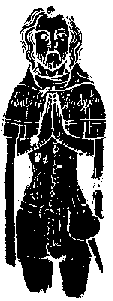 |
| Paleography
Exercises |
| 15th
century Brut Chronicle (British Library,
add. ms. 33242, f.140-141). All
images by permission of the British Library. |
|
|
|
| This
example is really fun. The double page illustrated is from an imperfect
copy of the Brut Chronicle which continues
into the reign of Richard II. Now if you have been assiduously studying
this website and have investigated the section entitled The
Written Word, you will know that the Brut originated as an English translation from Latin, via a French version, of Geoffrey of Monmouth's History
of the Kings of Britain, which describes the founding of Britain
by the Trojan Brutus and tells the story of King Arthur. In later centuries
more prosaic chronicles
were simply added on to the legendary Brut to extend the time frame. There is a common version to 1333, which exists
in various surviving manuscripts,
and a range of variants for the events which happened after that date.
|
| Now
there are people who believe that reading medieval chronicles is about
as interesting as watching grass grow, and that they are simply very brief
listings of kings, dates and battles. This fragment shows that there are
fascinating little insights to be excavated from them. |
|
The
segment starts prosaically enough with Edward III making his son Prince
of Wales. It follows with a brief description of the festivities when
Edward founded his round table, an event designed in imitation of his
famous legendary predecessor, Arthur. There is a curious entanglement
between life and art here, for as the king is turning myth into reality,
the chronicler is adding his words to the text of that myth. This event
was described in more lavish detail in other chronicles, and the actual
costs of the works done at Windsor Castle for the occasion survive in
exchequer
accounts. |
|
The round table in the hall of Winchester Castle. |
|
The
round table was a continuing symbol of English kingship. In this famous artifact, the paintwork is probably Tudor
in date, but it is just possible that this may be the object made for the
celebrations described in our chronicle here. Had these royal descendants
of the invading Normans chosen to forget that Arthur's fame was based
on defeating invaders? |
| In
the next sequence the chronicler completely loses the plot in terms of
making a sober record of events and launches into a tirade about the stupidity
of the English in adopting foolish foreign fashions in clothing from the
Hainaulters, Belgian court followers of the Queen, Philippa of Hainault.
It is true that around the mid 14th century some wild and crazy fashions
appeared, and styles of clothing which had remained relatively conservative
for centuries vanished under a series of waves of fashion change and competitiveness
in dress and appearance. |
 |
The
male figure here shows some of the new fashions that the chronicler complains
of. His tunic is very short. There are long extraneous dangly bits on
his sleeves, which are tight and fastened with a great row of tiny buttons.
Clearly the Apocalypse was at hand when men ran around like this! |
|
Rubbing
of a brass funerary memorial to an unknown man of c.1360 in the parish church
of Hampsthwaite, Yorkshire. |
| This
lady is wearing what is known as a sideless cote-hardie; a dress with
large panels missing in the side, revealing her garment beneath. She also
has great excesses of buttons down the front and on the sleeves. This
was also the beginning of the era of rapidly changing extravagant headgear
for women. Old books about brasses sometimes describe this particular
fashion as a reticulated headdress on the basis that it represents some
kind of fancy hairnet, but three dimensional tombs of the period show
that it is a cap with rows of tiny frills. As for the padding around the "arse", it is true that the lady appears to have somewhat exaggerated
curves, but I had always assumed that they were just drawn that way. Not
according to our chronicler, who gives us a hint at what ladies wore under
their cote-hardie. Note that the word "arse" was a perfectly
respectable word for bottom, backside or posterior in the 14th century. |
|
| Rubbing
of the brass effigy of Lady Margaret de Cobham, who died in 1375, in the church
of Cobham in Kent. |
|
After
this distraction, the chronicler sends Edward off to the seige of Calais,
and the page finishes with him burning, wasting and destroying a few hapless
French towns on his way. |
|
There
are some scribal
errors in the text, so that the odd sentence makes even less sense than
usual. The text is written in a series of enormously long sentences without
punctuation. There is some unusual spelling and some antiquated words,
which all makes decoding the text a little complicated. It is worth the
effort though, and shows that paleography
can be fun. |
|
|
overview | text | alphabet
| abbreviations | exercises
| transcript
| modern
paraphrase | |
|
Click
on each of the above to walk your way through a segment of the text. The
transcript will appear in a separate window so that you can use it for
reference at any time. These exercises are designed to guide you through
the text, not test you, so you can cheat as much as you like. |
 Script sample for this example Script sample for this example |
 Index of Exercises
Index of Exercises |
 Index of Scripts
Index of Scripts |
|
 |
 |
 |
 |



